Pecharsky V.K., Zavalij P.Y. Fundamentals of Powder Diffraction and Structural Characterization of Materials
Подождите немного. Документ загружается.


562 Chapter
6
specimen was prepared by filling a 1 mm deep cavity of a sample holder
without applying any pressure (see section 3.5) to minimize preferred
orientation effects.
Regardless of all precautions in the sample preparation, the pattern
(Figure 6.26) contains two distinct Bragg peaks, which are substantially
stronger than all others. The first peak at
-9.4O
(d
=
9.308 A) is shown at one
fourth of its height, and the second at -19.1"
(d
=
4.640 A) has intensity -4
times lower than the first, yet it is -3 times higher than any other Bragg
reflection. The intensities of the remaining Bragg reflections are below 10%
of the strongest. The d-spacing ratio for the two strongest peaks is 2.006,
which clearly indicates that they belong to the same zone, for example, 001
and 002 in the 001 zone. Combined with the markedly planar shape of the
crystallites (inset in
Figure 6.26), these features strongly suggest the
presence of a substantial preferred orientation, which may create problems in
solving the structure and in refining structural and profile parameters. On the
other hand, the fact that the two strongest reflections belong to the same
zone can be used to correct the observed peak positions for the sample
displacement or zero shift errors during the ab initio indexing, as was
actually done in the original
work.]
Semi-manual profile fitting was conducted using WinCSD (see the
footnote on page 515). The first 41 peaks in the range below
20
=
39" were
indexed using the IT0 program in a monoclinic unit cell
(Mzo
=
37),
which
was the best and the only solution with all peaks indexed. The unit cell
refinement resulted in a
=
18.453 A,
b
=
6.560 A,
c
=
8.437 A,
P
=
91.12O,
and
V
=
1021.1 A3. Analysis of the systematic absences results in h
+
1
=
2n
for h01 reflections and 1
=
2n for 001 reflections, which unambiguously points
out to P2Jn (P2Jc in standard setting) as the only possible space group
symmetry. Moreover,
P2,Ic is one of the most common groups observed
among natural and man-made materials.
Due to the complexity of the pattern, multiple overlaps (e.g, about 90
Bragg reflections are possible in the range of the first 40 observed peaks
below
20
=
40") and the relatively broad peaks, the pattern decomposition
was carried out using a semi-manual profile fitting. For each group of Bragg
reflections, located within the manually selected ranges of the powder
This example can be used to illustrate an interesting approach that may be helpful in the
indexing from first principles. Assume that two patterns were collected from the same
powder. The first, using a specimen with minimum or no preferred orientation, and the
second with artificially induced strong texture. Provided the texture axis coincides with
one of the principal crystallographic directions
(e.g. [OOl], [OlO], or [OOl]), the
comparison of two patterns may provide critical information about the indices of certain
peaks, whose intensity was affected (increased or reduced) the most. Once their indices are
determined by analyzing the ratios between the corresponding d-spacings, the problem of
finding the remaining lattice parameters is simplified by eliminating one unknown.
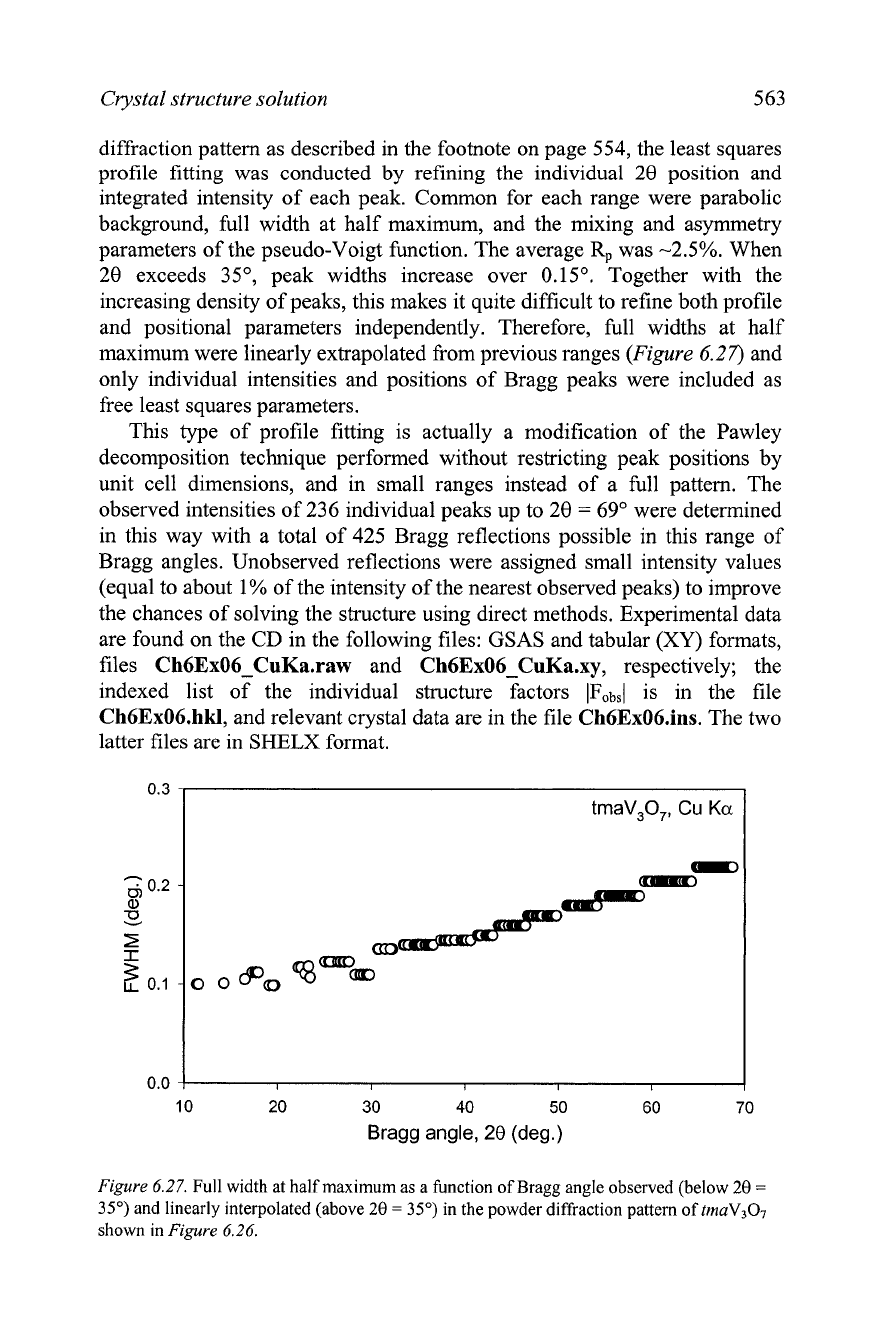
Crystal structure solution
563
diffraction pattern as described in the footnote on page 554, the least squares
profile fitting was conducted by refining the individual 28 position and
integrated intensity of each peak. Common for each range were parabolic
background, full width at half maximum, and the mixing and asymmetry
parameters of the pseudo-Voigt function. The average
Rp
was
-2.5%.
When
28 exceeds 35O, peak widths increase over 0.15O. Together with the
increasing density of peaks, this makes it quite difficult to refine both profile
and positional parameters independently. Therefore, full widths at half
maximum were linearly extrapolated from previous ranges
(Figure
6.27)
and
only individual intensities and positions of Bragg peaks were included as
free least squares parameters.
This type of profile fitting is actually a modification of the Pawley
decomposition technique performed without restricting peak positions by
unit cell dimensions, and in small ranges instead of a full pattern. The
observed intensities of 236 individual peaks up to
28
=
69" were determined
in this way with a total of 425 Bragg reflections possible in this range of
Bragg angles. Unobserved reflections were assigned small intensity values
(equal to about
1%
of the intensity of the nearest observed peaks) to improve
the chances of solving the structure using direct methods. Experimental data
are found on the CD in the following files:
GSAS
and tabular
(XY)
formats,
files Ch6ExO6-CuKa.raw and Ch6Ex06-CuKa.xy, respectively; the
indexed list of the individual structure factors
IFobs(
is in the file
Ch6Ex06.hk1, and relevant crystal data are in the file Ch6Ex06.ins. The two
latter files are in
SHELX
for&at.
10 20 30 40 50 60
70
Bragg angle,
28
(deg.)
Figure
6.27.
Full width at half maximum as a function of Bragg angle observed (below
28
=
35')
and linearly interpolated (above
28
=
35")
in the powder diffraction pattern of
tmaV3O7
shown in
Figure
6.26.
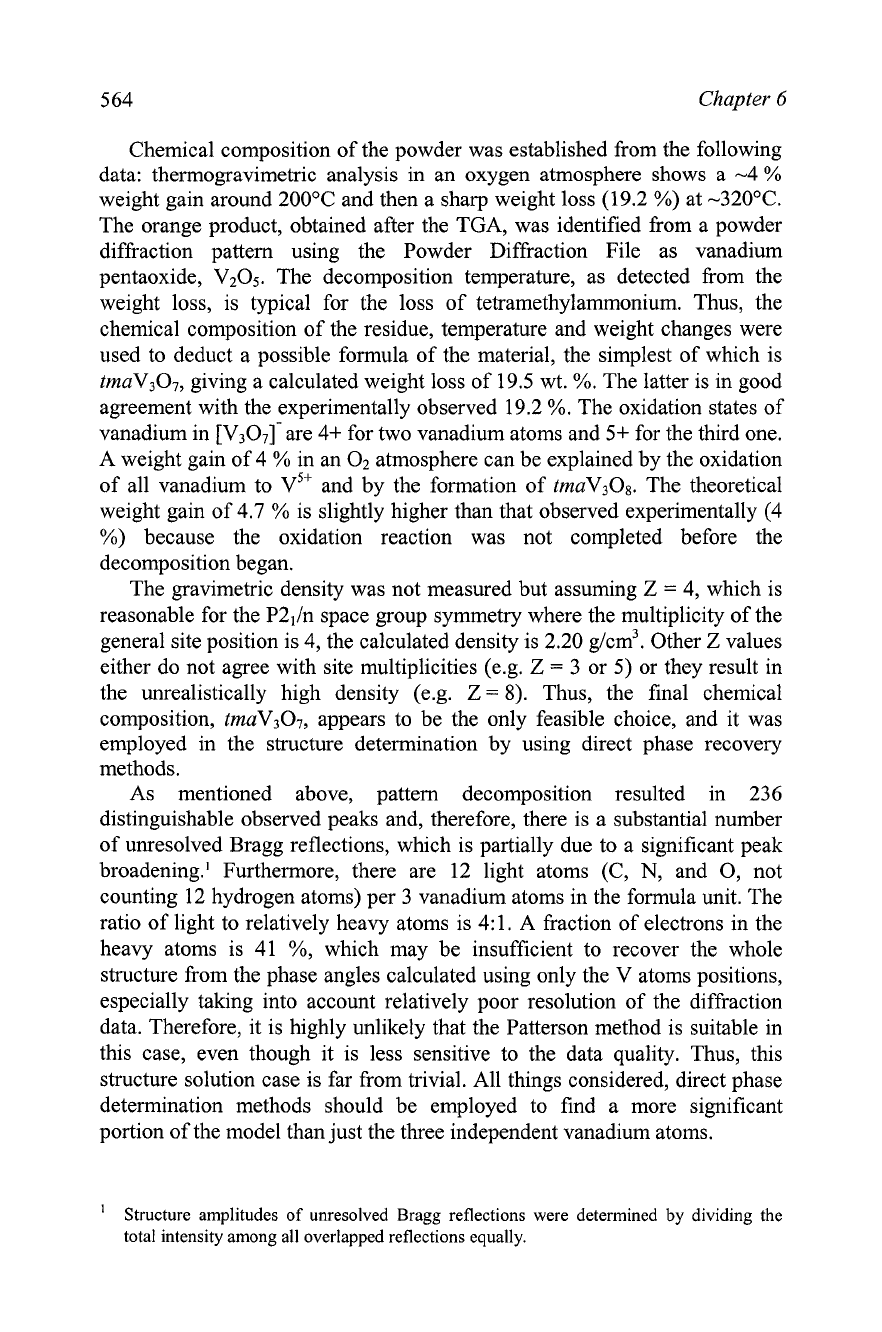
5 64 Chapter
6
Chemical composition of the powder was established from the following
data: thermogravimetric analysis in an oxygen atmosphere shows a
-4
%
weight gain around 200•‹C and then a sharp weight loss (19.2
%)
at -320•‹C.
The orange product, obtained after the TGA, was identified from a powder
diffraction pattern using the Powder Diffraction File as vanadium
pentaoxide,
V2O5. The decomposition temperature, as detected from the
weight loss, is typical for the loss of tetramethylammonium. Thus, the
chemical composition of the residue, temperature and weight changes were
used to deduct a possible formula of the material, the simplest of which is
tmaV3O7, giving a calculated weight loss of 19.5 wt.
%.
The latter is in good
agreement with the experimentally observed 19.2
%.
The oxidation states of
vanadium in [v307]- are 4+ for two vanadium atoms and
5+
for the third one.
A weight gain of 4
%
in an O2 atmosphere can be explained by the oxidation
of all vanadium to
v5+
and by the formation of tmaV308. The theoretical
weight gain of
4.7
%
is slightly higher than that observed experimentally (4
%)
because the oxidation reaction was not completed before the
decomposition began.
The gravimetric density was not measured but assuming
Z
=
4, which is
reasonable for the P21/n space group symmetry where the multiplicity of the
general site position is 4, the calculated density is 2.20 g/cm3. Other
Z
values
either do not agree with site multiplicities (e.g.
Z
=
3 or 5) or they result in
the unrealistically high density (e.g.
Z
=
8).
Thus, the final chemical
composition, tmaV307, appears to be the only feasible choice, and it was
employed in the structure determination by using direct phase recovery
methods.
As mentioned above, pattern decomposition resulted in 236
distinguishable observed peaks and, therefore, there is a substantial number
of unresolved Bragg reflections, which is partially due to a significant peak
broadening.' Furthermore, there are 12 light atoms (C,
N,
and 0, not
counting 12 hydrogen atoms) per
3
vanadium atoms in the formula unit. The
ratio of light to relatively heavy atoms is 4:l.
A
fraction of electrons in the
heavy atoms is 41
%,
which may be insufficient to recover the whole
structure from the phase angles calculated using only the V atoms positions,
especially taking into account relatively poor resolution of the diffraction
data. Therefore, it is highly unlikely that the Patterson method is suitable in
this case, even though it is less sensitive to the data quality. Thus, this
structure solution case is far from trivial. All things considered, direct phase
determination methods should be employed to find a more significant
portion of the model than just the three independent vanadium atoms.
'
Structure amplitudes of unresolved Bragg reflections were determined by dividing the
total intensity among all overlapped reflections equally.

Crystal structure solution 565
The structure was solved using SHELXS-90 based on the extracted
structure amplitudes of
425
possible reflections below
29
=
70". The direct
phase determination with
E~,
=
1.1 resulted in the E-map containing an
acceptable model with three "heavy" peaks (Table 6.38) that were
automatically assigned to vanadium. The distances from the vanadium atoms
to all but one from the list of nine strongest peaks are a good match for
V-0
bonds. The only exception is 44, which is too far from all V atoms and too
close to 46 (1.32 A). The 44-46 distance is not listed in Table 6.38.
Since the 46 distance to V3 is nearly ideal (1 239 A), the Q6 but not the
44 peak was included into the trial model. One of the peaks, Q5, is not in
contact with vanadium or oxygen atoms, and it was treated as nitrogen.
Peaks following Q9 have conflicting distances with the first 12 strongest
maxima. The analysis of bond angles and coordination polyhedra confirms
the reasonableness of this model. Its composition,
V3O7 plus one isolated
light atom (presumably nitrogen from the tetramethylammonium molecule),
agrees well with the TGA data, symmetry restrictions and estimated density.
Table
6.38.
Maxima localized from the E-map refined for the best solution obtained by
SHELXS-90 using 425 reflections data below 70" 29; Emi,=l. 1.
Atom/
uid
Bond distances,
A
Peak
Y
z
Height
Via
V2a V3a
commentsb
0.794 0.176 0.019 429.9
0.722
0.683
0.069 342.8
0.785 -0.112 -0.252 281.2
0.797 0.189 -0.211 178.5 1.94 2.01 Ola
0.736 0.482 -0.031 151.7 2.31 1.59 1.96 02a
0.892 0.192 0.068 137.1 1.85 03a
0.664 0.019 -0.193 133.3 2.46 Deleted
1.040 0.270 -0.308 132.3 N5a
0.862 -0.295 -0.284 124.2 1.89 06a
0.815 -0.129 0.037 121.1 2.05 2.15 07a
0.760 0.263 0.242 116.8 2.07 1.71
08a
d9 0.685 0.1 18 0.040 114.7 2.06 09a
a
This column lists the distances to the indicated atom in
A.
The names assigned to atoms consist of the chemical symbol of the element, E-map or
Fourier map peak number, and a letter (if any), which indicates the sequential number of
the calculated Fourier map: a
-
corresponds to the first iteration, b
-
second, and so on.
The least squares refinement of this model using SHELXL-97 yields
RF
=
42
%
as shown in Table 6.39. All oxygen atoms and the isolated nitrogen
atom look reasonable because their distances to the vanadium atoms are
within acceptable limits. What is not shown in Table 6.39 is that the
coordination polyhedra of V atoms make both chemical and physical sense:
vanadium oxide forms a layer, composed of V05 pyramids and tetrahedral
V04, as illustrated in Figure 6.28. This layer is similar to layers known for
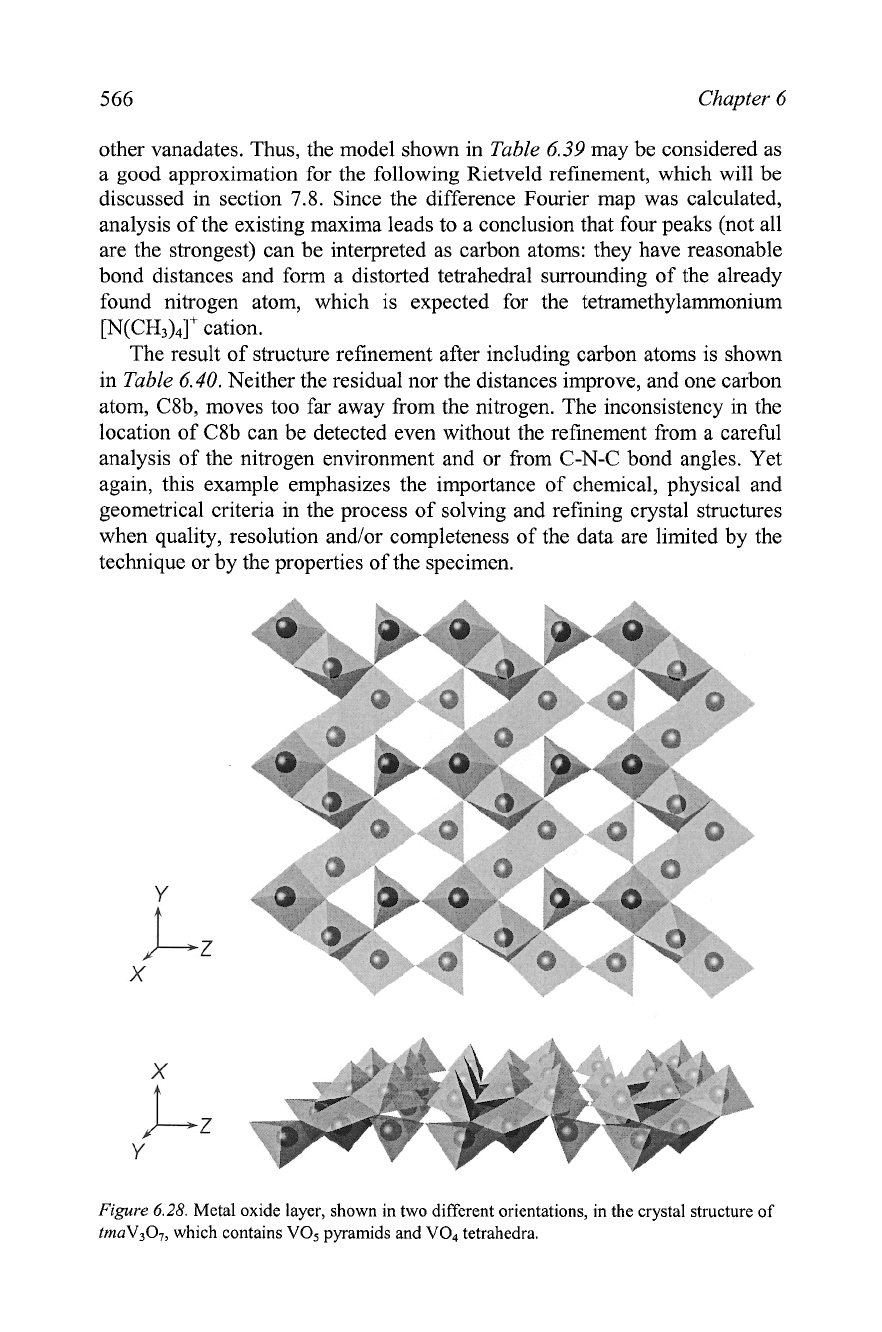
5
66
Chapter
6
other vanadates. Thus, the model shown in
Table
6.39
may be considered as
a good approximation for the following Rietveld refinement, which will be
discussed in section
7.8.
Since the difference Fourier map was calculated,
analysis of the existing maxima leads to a conclusion that four peaks (not all
are the strongest) can be interpreted as carbon atoms: they have reasonable
bond distances and form a distorted tetrahedral surrounding of the already
found nitrogen atom, which is expected for the tetramethylammonium
[N(CH&]+ cation.
The result of structure refinement after including carbon atoms is shown
in
Table
6.40.
Neither the residual nor the distances improve, and one carbon
atom, C8b, moves too far away from the nitrogen. The inconsistency in the
location of C8b can be detected even without the refinement from a careful
analysis of the nitrogen environment and or from C-N-C bond angles. Yet
again, this example emphasizes the importance of chemical, physical and
geometrical criteria in the process of solving and refining crystal structures
when quality, resolution andlor completeness of the data are limited by the
technique or by the properties of the specimen.
Figure
6.28.
Metal oxide layer, shown in two different orientations, in the crystal structure of
tmaV307,
which contains
V05
pyramids and
V04
tetrahedra.

Crystal structure solution 567
Table
6.39
Coordinates of atoms after structure refinement using SHELX and peaks found on
the difference Fourier map, which may correspond to possible locations of carbon atoms. All
data below
28
=
70' were used; RF
=
42
%.
Atom/
z
Uisol
Bond distances,
A
Y
Height Vla V2a V3a N5a
Comments
Peak
V1 0.791 0.178 1.015 0.016
v2
v3
Ola
02a
03 a
O6a
07a
08a
09a
N5a
43
Q8
Q9
Qll -0.001 0.072 0.736 2.1 1.34 Cl
lb
a
This column lists the distances to the indicated atom in
A.
Table
6.40
Results of structure refinement by using SHELX; RF
=
42
%.
Coordinates of all
atoms were shifted by a vector (-1/2,0, -112) when Eompared to
Table
6.39.
Atom1 Uisol Bond distances,
A
Comments
Peak
Y
z
Height Vla V2a V3a N5aa
V1 0.292 0.182 0.513 0.011
v2
v3
Ola
02a
03 a
06a
07a
08a
09a
NSa
C3b
C8b
C9b
1.05
1 .go Incorrect
1.17
Cllb -0.508 0.078 0.226 0.000 1.3
1
a
This column lists the distances to the indicated atom in
A.
The high value of
RF
and poor convergence of the model (for example,
the
C-N
and 06a-V3 bond distances are getting worse instead of improving)
are due to both the low resolution and the suspected strong preferred
orientation, which was discussed at the beginning of this section but not
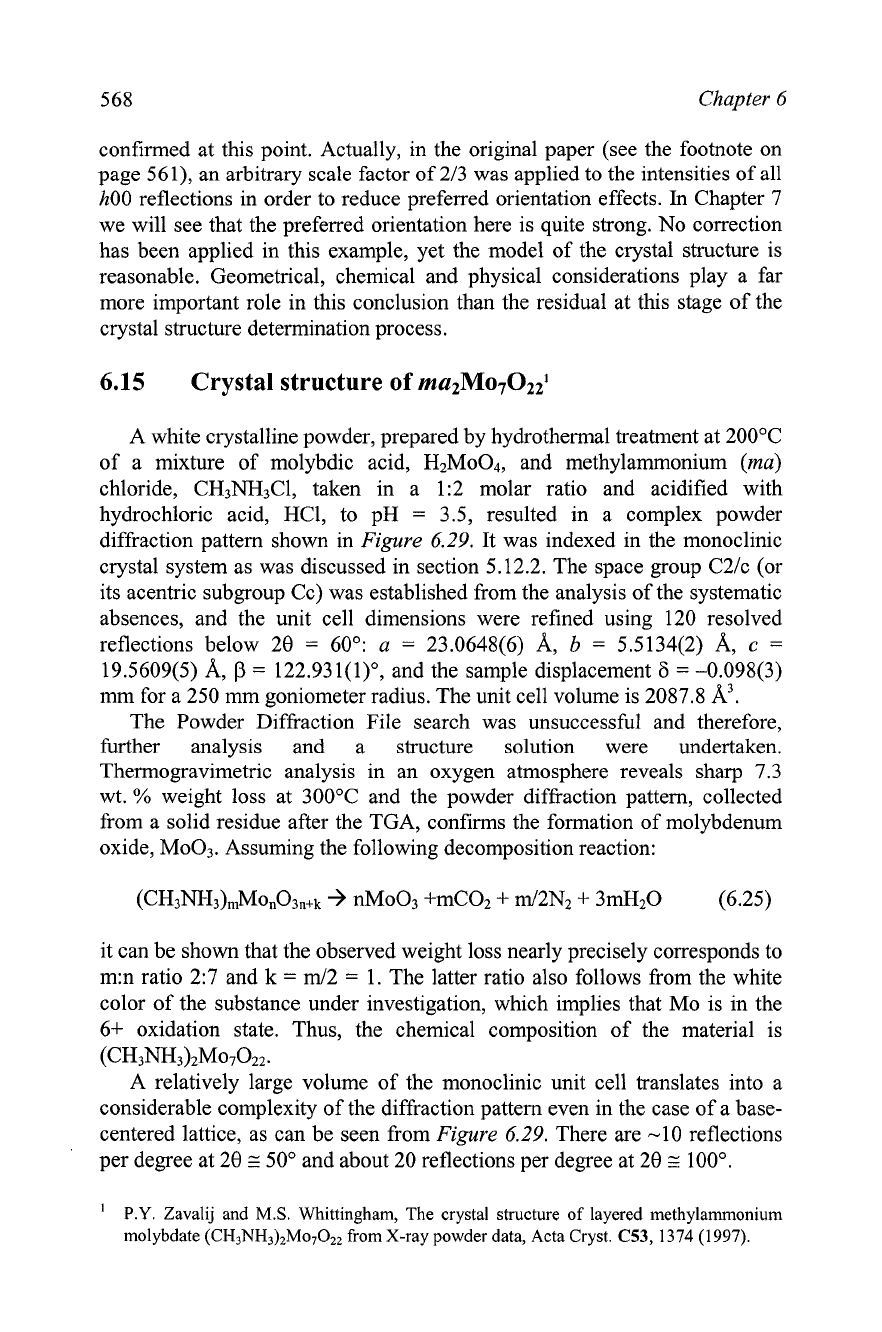
568 Chapter
6
confirmed at this point. Actually, in the original paper (see the footnote on
page
561),
an arbitrary scale factor of 213 was applied to the intensities of all
hOO reflections in order to reduce preferred orientation effects.
In
Chapter 7
we will see that the preferred orientation here is quite strong. No correction
has been applied in this example, yet the model of the crystal structure is
reasonable. Geometrical, chemical and physical considerations play a far
more important role in this conclusion than the residual at this stage of the
crystal structure determination process.
6.15
Crystal structure
of ma2M070221
A
white crystalline powder, prepared by hydrothermal treatment at 200•‹C
of a mixture of molybdic acid, H2Mo04, and methylammonium
(ma)
chloride, CH3NH3Cl, taken in a 1:2 molar ratio and acidified with
hydrochloric acid, HC1, to pH
=
3.5, resulted in a complex powder
diffraction pattern shown in
Figure
6.29. It was indexed in the monoclinic
crystal system as was discussed in section 5.12.2. The space group C2Ic (or
its acentric subgroup Cc) was established from the analysis of the systematic
absences, and the unit cell dimensions were refined using 120 resolved
reflections below 29
=
60': a
=
23.0648(6) A,
b
=
5.5134(2) A,
c
=
19.5609(5) A,
p
=
122.931(1)O, and the sample displacement
6
=
-0.098(3)
mm for a 250 mm goniometer radius. The unit cell volume is 2087.8 A3.
The Powder Diffraction File search was unsuccessful and therefore,
further analysis and a structure solution were undertaken.
Thermogravimetric analysis in an oxygen atmosphere reveals sharp 7.3
wt.
%
weight loss at 300•‹C and the powder diffraction pattern, collected
from a solid residue after the TGA, confirms the formation of molybdenum
oxide, Moo3. Assuming the following decomposition reaction:
it can be shown that the observed weight loss nearly precisely corresponds to
m:n ratio 2:7 and k
=
m/2
=
1. The latter ratio also follows from the white
color of the substance under investigation, which implies that Mo is in the
6+
oxidation state. Thus, the chemical composition of the material is
(CH3m3)2M07022.
A
relatively large volume of the monoclinic unit cell translates into a
considerable complexity of the diffraction pattern even in the case of a base-
centered lattice, as can be seen from
Figure
6.29. There are -10 reflections
per degree at 28
G
50' and about 20 reflections per degree at 29
z
100".
'
P.Y.
Zavalij and
MS.
Whittingham, The crystal structure of layered methylammonium
molybdate (CH3NH3)2M07022 from X-ray powder data, Acta Cryst.
C53,
1374 (1997).
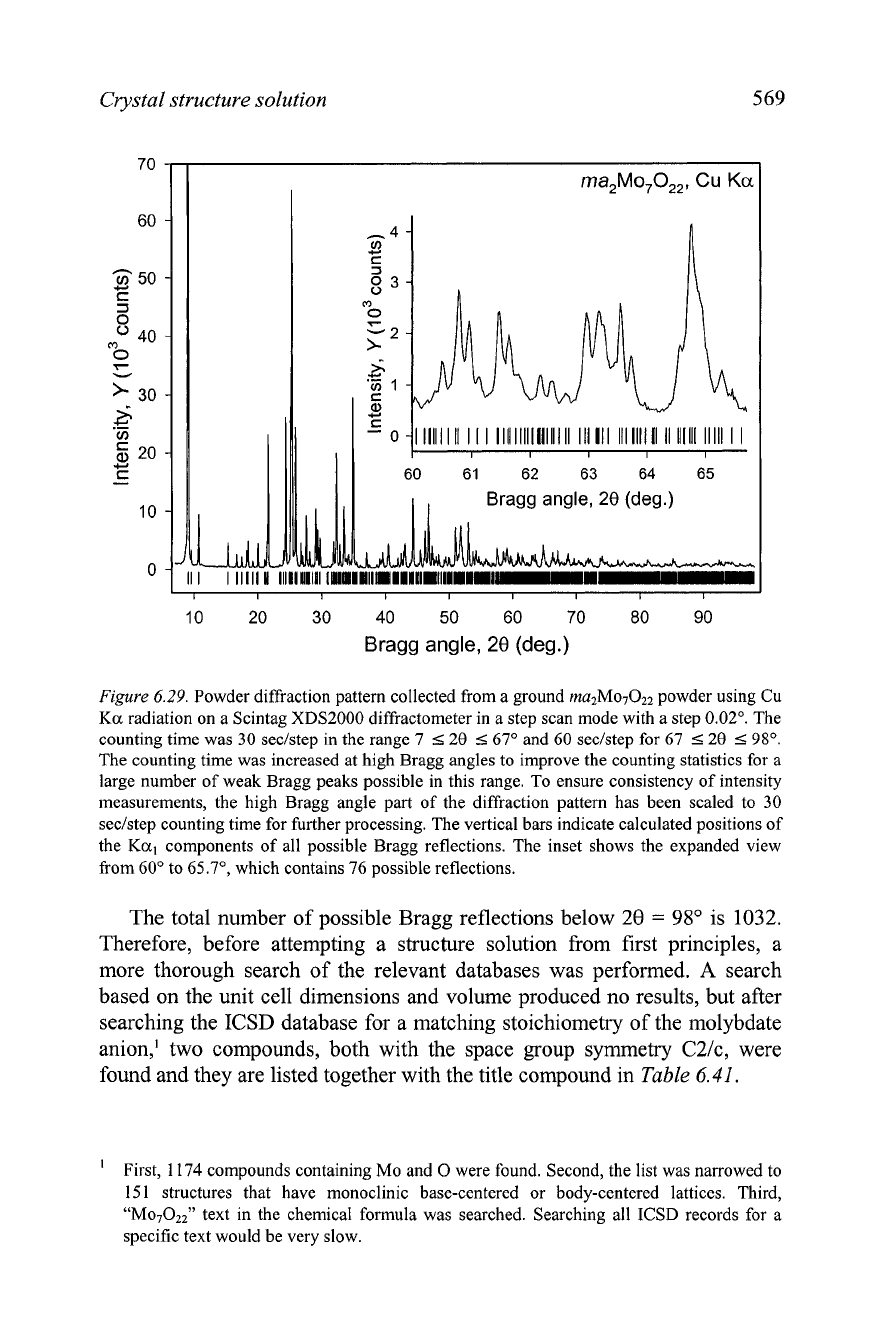
Crystal structure solution
5
69
60
61
62
63
64
65
Bragg angle,
20
(deg.)
10 20 30 40 50 60 70 80 90
Bragg angle,
20
(deg.)
Figure
6.29.
Powder diffraction pattern collected from a ground rna2M07022 powder using Cu
Ka
radiation on a Scintag XDS2000 diffractometer in a step scan mode with a step 0.02'. The
counting time was 30 seclstep in the range 7
5
20
2
67' and 60 seclstep for 67
5
28
5
98'.
The counting time was increased at high Bragg angles to improve the counting statistics for a
large number of weak Bragg peaks possible in this range. To ensure consistency of intensity
measurements, the high Bragg angle part of the diffraction pattern has been scaled to 30
seclstep counting time for further processing. The vertical bars indicate calculated positions of
the
Ka,
components of all possible Bragg reflections. The inset shows the expanded view
from
GO0
to 65.7', which contains 76 possible reflections.
The total number of possible Bragg reflections below
29
=
98'
is
1032.
Therefore, before attempting a structure solution from first principles, a
more thorough search of the relevant databases was performed.
A
search
based on the unit cell dimensions and volume produced no results, but after
searching the
ICSD
database for a matching stoichiometry of the molybdate
anion,' two compounds, both with the space group symmetry C2/c, were
found and they are listed together with the title compound in
Table
6.41.
First, 1174 compounds containing Mo and
0
were found. Second, the list was narrowed to
15 1
structures that have monoclinic base-centered or body-centered lattices. Third,
"Mo7022)' text in the chemical formula was searched. Searching all ICSD records for a
specific text would be very slow.
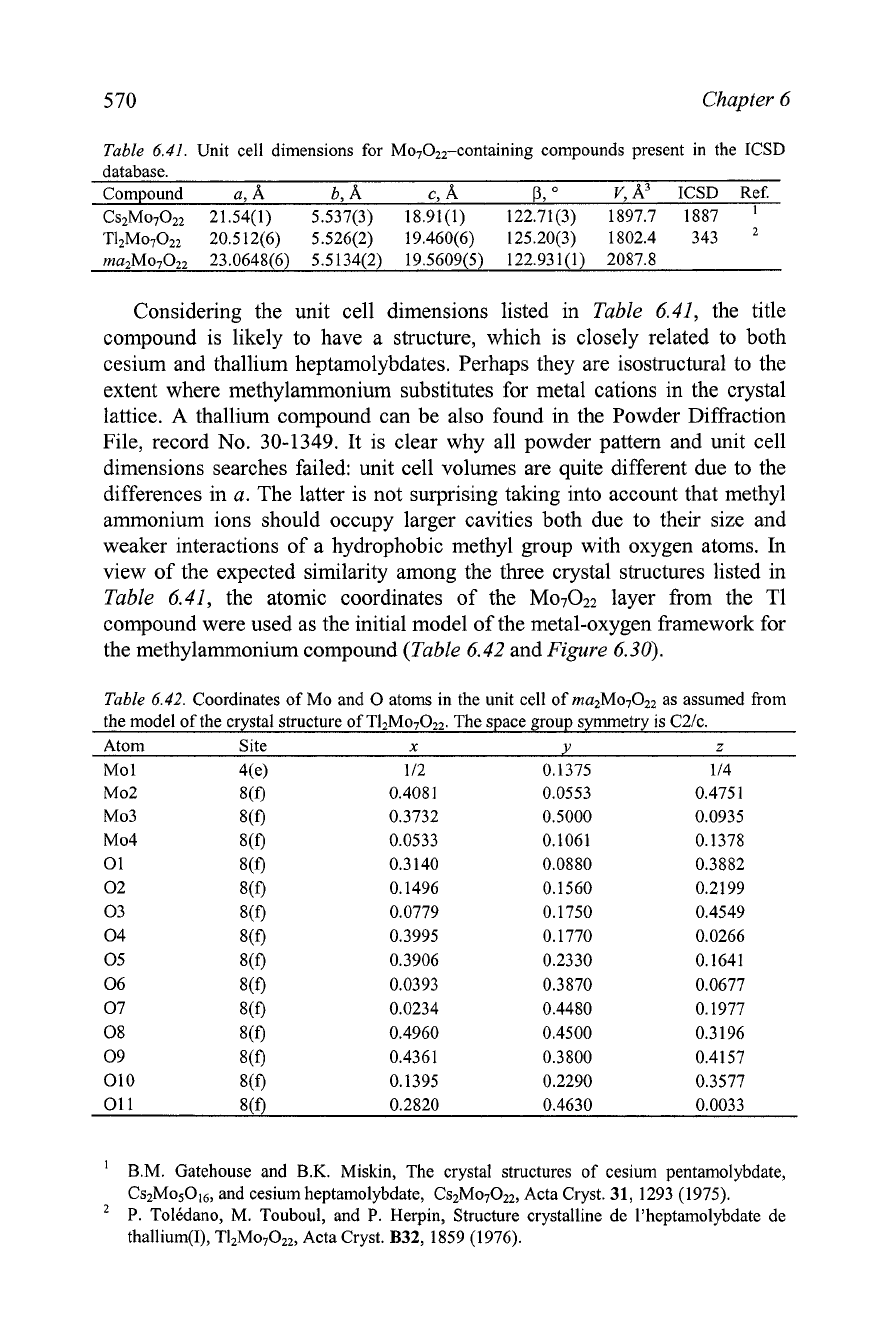
5
70
Chapter
6
Table
6.41.
Unit cell dimensions for Mo7OZ2-containing compounds present in the ICSD
database.
Compound a,
A
b,
A
c,
8,
0
V,
A3
ICSD Ref.
Cs2M0702, 21.54(1) 5.537(3) 18.91(1) 122.71(3) 1897.7 1887
T1zMo7022 20.5 12(6) 5.526(2) 19.460(6) 125.20(3) 1802.4 343
rna2M07022 23.0648(6) 5.5134(2) 19.5609(5) 122.93 l(1) 2087.8
Considering the unit cell dimensions listed in
Table
6.41, the title
compound is likely to have a structure, which is closely related to both
cesium and thallium heptamolybdates. Perhaps they are isostructural to the
extent where methylammonium substitutes for metal cations in the crystal
lattice. A thallium compound can be also found in the Powder Diffraction
File, record No. 30-1349. It is clear why all powder pattern and unit cell
dimensions searches failed: unit cell volumes are quite different due to the
differences in
a.
The latter is not surprising taking into account that methyl
ammonium ions should occupy larger cavities both due to their size and
weaker interactions of a hydrophobic methyl group with oxygen atoms. In
view of the expected similarity among the three crystal structures listed in
Table
6.41, the atomic coordinates of the Mo7022 layer from the T1
compound were used as the initial model of the metal-oxygen framework for
the methylammonium compound
(Table
6.42 and
Figure
6.30).
Table
6.42.
Coordinates of Mo and
0
atoms in the unit cell of mazMo7022 as assumed from
the model of the crystal structure of Tl2Mo7OZ2. The space group symmetry is C21c.
Atom Site
x
Y
z
Mo 1 4(e) 1 I2 0.1375 1 I4
Mo2 8(f) 0.4081 0.0553 0.475
1
Mo3 Wf) 0.3732 0.5000 0.0935
Mo4 8(f) 0.0533 0.1061 0.1378
01 8(f) 0.3140 0.0880 0.3882
02 8(f) 0.1496 0.1560 0.2199
03
8(f) 0.0779 0.1750 0.4549
04 8(f) 0.3995 0.1770 0.0266
05 8(f) 0.3906 0.2330 0.1641
06 8(f) 0.0393 0.3870 0.0677
07 8(f) 0.0234 0.4480 0.1977
08
8(f) 0.4960 0.4500 0.3 196
09 8(f) 0.4361 0.3800 0.4157
010 8(f) 0.1395 0.2290 0.3577
01 1 8(f) 0.2820 0.4630 0.0033
'
B.M. Gatehouse and B.K. Miskin, The crystal structures of cesium pentamolybdate,
and cesium heptamolybdate, CS~MO~O~~, Acta Cryst.
31,
1293 (1975).
P.
TolCdano, M. Touboul, and
P.
Herpin, Structure crystalline de I'heptamolybdate de
thallium(I), TI2Mo7Oz2, Acta Cryst.
B32,
1859 (1976).

Crystal structure solution
571
Figure
6.30.
Metal oxide layer in the crystal structure of maMo7OZ2, shown in two different
orientations. The Mo atoms are shown as large dark grey spheres, and the
0
atoms as small
grey spheres.
If our hypothesis about the relationship between the crystal structures of
T12Mo7022 and mazMo7Oz2 is correct, refining relevant atomic parameters
and completing the model, i.e. finding the coordinates of missing
methylammonium groups should be easier done after the Rietveld
refinement, which will de described in the next chapter, section
7.9.
Experimental data are found on the
CD
in the data files
Ch6Ex07-CuKa.xy
and
Ch6Ex07-CuKa.raw.
6.16
Crystal structure
of
Mn7(OH)3(V04)41
A diffi-action pattern (Figure 6.31) collected using a powder prepared
from brown rod-like hollow crystals produced hydrothermally2 (Figure 6.31,
'
Idealized composition without vacancies;
F.
Zhang,
P.Y.
Zavalij, and MS. Whittingham,
Synthesis and characterization of a pipe-structure manganese vanadium oxide
by
hydrothermal reaction,
J.
Mater. Chem., 9,3137 (1999).
The material was prepared by hydrothermal treatment of V2O5, Mn(CH3C00)2 and
N(CH3)&I taken in
1
:
1
:4
molar ratio at
165
"C for
3
days.
